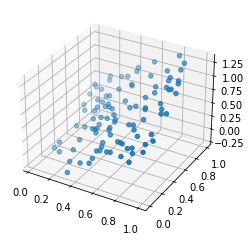Chapter 8 : Dimensionality Reduction
Notes
Dimensionality Reduction
- The primary reason for dimensionality reduction is that it speeds up training without a loss in performance.
- Examples:
- Merging pixels in an image which are neighbors
- Removing bordering pixels from an image
The Curse of Dimensionality
- Many things behave much differently in higher dimensions
- The distance between two points in a unit square (2D) is 0.52, but in a 1,000,000 dimensional hypercube it is 408.25 (1,000,000 / 6)^0.5. This shows that large dimensional datasets are inherently sparse (i.e. training samples lie far from one another).
- The more dimensions a training set has the greater the risk of overfitting
Main Approaches for Dimensionality Reduction
- Two main approaches to dimensionality reduction: projection and Manifold Learning
Projection
- An example would be projecting a 3D dataset down to a 2D plane
- However, it’s not always trivial to make this projection. Seen below is the Swiss roll toy dataset. The first row projection does a much better job of preserving the separation of data

Manifold Learning
- This Swiss roll is an example of a 2D manifold
- A 2D manifold is a 2D shape that can be manipulated into a higher-dimensional space
- Many dimensionality reduction algorithms work by modeling the manifold on which the training instances lie (known as Manifold Learning)
- The manifold hypothesis states that most real-world high-dimensional datasets lie close to a much lower-dimensional manifold
- Another assumption follows, that machine learning will be simpler if expressed in the lower-dimensional space
- This is not always true however, occassionally the original orientation of the data better preserves its structure
PCA
- Principal Component Analysis (PCA) is the most popular dimensionality reduction technique
- It works by finding the hyperplane which lies closest to the data and then projecting the data onto that hyperplane
Preserving the Variance
- In order to project the data, it’s best to select the hyperplane which preserves the maximum amount of variance in the dataset and this is the objective of PCA
Principal Components
- PCA identifies the axis which accounts for the largest amount of variance in the dataset
- If it were a higher-dimensional dataset, PCA would also find the next orthogonal axis which contains the most variance
- The unit vector that defines the ith axis is called the ith principal component (PC)
- Use Singular Value Decomposition (SVD) to split the training set matrix into three components:

- Here V* contains all principal components
- PCA assumes that the dataset is centered around the origin
Projecting Down to d Dimensions
- After identifying the principal components, dimensionality is reduced by projecting the dataset onto the d dimensions
Using Scikit-Learn
from sklearn.decomposition import PCA
import numpy as np
import matplotlib.pyplot as plt
X = np.random.random((100, 2))
X = np.concatenate((X, np.abs(np.sum(X, axis=1)).reshape((-1, 1)) - 0.5), axis=1)
ax = plt.figure().add_subplot(projection='3d')
ax.scatter(X[:, 0], X[:, 1], X[:, 2])
pca = PCA(n_components=2)
X2D = pca.fit_transform(X)
print(pca.components_)
[[ 0.41519158 0.40126542 0.81645699]
[-0.70305236 0.71109263 0.00804027]]

Explained Variance Ratio
- The explained variance ratio allows you to determine how much variance lies along each principal component
Choosing the Right Number of Dimensions
- Generally you would reduce down to as many dimensions as can account for most of the variance (95%)
- For data visualization you’ll want to reduce down to 2 or 3 dimensions so anyone can see what’s going on
- You can use a float between 0.0 and 1.0 to get the appropriate number of dimensions to explain 95% of the variance (i.e.
n_components = 0.95)
PCA for Compression
- For MNIST PCA covering 95% of the variance reduces from 784 to 150 features
- You can use the inverse transformation to decompress the data back to its original dimensions
- The 5% unaccounted for variance during this inverse transformation is know as the reconstruction error
Incremental PCA
- Incremental PCA allows you to run PCA without needing the whole dataset to do SVD
- See
sklearn.decomposition.IncrementalPCAfor details
Randomized PCA
- Randomized PCA uses a stochastic algorithm to quickly find an approximation of the first d principal components
- It’s faster when $d « n$
Kernel PCA
- Kernel PCA uses the kernel trick to apply PCA to nonlinear projections for dimensionality reduction
- It is often good at preserving clusters of instances after projection, or sometimes even unrolling datasets that lie close to a twisted manifold
- Swiss roll example using various kernels:

Selecting a Kernel and Tuning Hyperparameters
- There’s no obvious performance measure for kPCA so it can be combined with grid search to produce the best end result : /
- There is no true reconstruction error because of the way the kernel trick works. Instead there is what’s known as a pre-image which to my understanding is an approximation of the 2D reduced data, but in the original space. It serves as an approximate way to calculate the reconstruction error.
- Reducing the pre-image reconstruction error is a viable way to find the best kernel for dimensionality reduction (e.g. through grid search on parameters)
LLE
- Locally Linear Embedding (LLE) is a non-linear dimensionality reduction technique
- It works by measuring the linear relationship to a data points neighbors and then trying to produce a lower dimensional representation of that data where those relationships are still preserved
- Good for complex manifolds, but doesn’t scale to large datasets
Other Dimensionality Reduction Techniques
- Multidimensional Scaling (MDS) - reduces dimensionality whilst trying to preserve the distances between the instances
- Isomap - Tries to preserve geodesic distances between instances
- t-Distributed Stochastic Neighbor Embedding (t-SNE) - Keep similar instances close and dissimilar instances far apart through dimensionality reduction
- Linear Discriminant Analysis (LDA) - A classification algorithm which finds the most discriminative axes between classes
